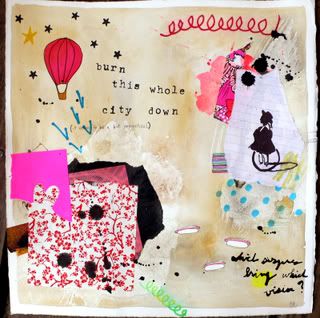
Cara Ober. i am who i pretend to be. 40x40. mixed media on canvas.
“Despite what the Baltimore Sun says, I am not angry about this any more,” says Baltimore artist Cara Ober. She is the subject of a story on a Baltimore exhibit, one that sort of features her work. It’s her work, all right, but by a different artist: Christine Bailey. For the show at 100 East Pratt Street in downtown Baltimore, Bailey made paintings that ape everything about Ober’s unmistakable style.
“And I would be fine with this project if it had included 3 artists,” says Ober, referring to Bailey’s original vision for the show, in which she would style-check other artists, not just Ober. “And I would be fine with it if they had just named me from the start.”
Now the Baltimore-based artist is fielding criticism from further afield: Blake Gopnik dismisses her in the Washington Post.
The newspaper’s chief art critic, who writes a reported review of Bailey’s show, discloses that his wife (artist Lucy Hogg) works with Christine Bailey. Bailey and Hogg are reportedly good friends, but never mind. Baltimore is a ways for a critic to travel who doesn’t write the galleries beat. Not only is the show across the way, it’s also not really a gallery show—Bailey’s work is hung in the lobby of an office building.
By the Post’s reporting, the show falls in line with the appropriation back-and-forth that’s occupied artists for the better part of the twentieth century. (My favorite recent example is Jill Miller’s mashup of Missy “Misdemeanor” Elliott, John Baldessari, and herself, titled I Am Making Art, Too. This piece illustrates the way that appropriation almost always works: A younger artist samples a highly known piece by an established artist to make a point about practice, politics, or whatever. Appropriation is typically greeted as a sign of respect, a nod from teacher to student, and it tends to be more subtle, an Easter egg for critics on the lookout.)
Bailey’s is a new escalation in a game of oneupmanship, Gopnik argues. Bailey and Ober are peers, both relatively unknown in the national context, and artists competing in the same market. That’s something of a new commercial twist. In fact, there are a number of commercial twists in this show.
One is that it’s hung in the lobby of an office building—a venue that’s not adequate to the task of providing any historical or critical context for the show. Nor did Bailey and the exhibit’s curator, Jordan Faye Block, make any effort to provide that context in explanatory text. The original text that hung with the show made no reference to Ober’s work. In fact, it’s arguable that Bailey obscured the fact.
“Combining imagery and text from various sources, including the web, pop culture, the urban environment and art history, the pictures are at once whimsical and melancholy,” the original press release reads. That sounds like Ober describing the work, not Bailey. Bailey didn’t mention Ober at all—not even in a roundabout fashion—until Ober threatened legal action. (Block has since posted a “clarification,” a revised statement in which Bailey writes that she “used the work of Ms. Ober, among others, as a point of reference” in pieces that adopted the notion of “designer replicas”.)
“However much the paintings might look like Ober’s,” writes Gopnik, “Bailey isn’t using that look to the same ends that Ober, or an Ober forger, would.” If Bailey doesn’t mention Ober—and if Bailey makes claims about the substance and not the situation of these paintings—how can this be true?
Another commercial angle: Block, who represents Bailey now, used to represent Ober.

Cara Ober. Burn this whole city down. 2007.
“I did my first gallery show with [Block] when she was the director at Gallery Imperato—’Femme Effect Part Deux’ in April 2006,” Ober explains. “The Femme Effect show was during the height of the housing boom and she sold a good deal of my work. Like 16 pieces. Most were small and inexpensive. She even bought one for herself.” Block left the gallery, but Ober stayed on. “I decided to stay with Gallery Imperato for professional reasons.”
Block describes her own split with Gallery Imperato as “a philosophical difference in vision.”
Ober’s contract with Gallery Imperato allowed her to participate in group shows at other spaces (provided that the show included five artists or more). Ober says that Block pursued her, and she agreed to participate in two of Block’s post-Imperato shows—curated independently under the mantle Jordan Faye Contemporary at various sites.
One of those shows was “Believe It: 14 Painters”, a May 2007 show at the Creative Alliance at the Patterson in Baltimore, in which Block came in for some criticism for painting her gallery logo—a Tiffany box–blue outline of a square—on the gallery floor. Some, like commenters and contributors on Ober’s art blog, thought this distracted from the work. “After that show, I decided that would be the last show I worked with her on.”
“The show’s not about Cara Ober,” says Block. “It’s about authorship, originality, it’s trying to question all those things. It’s a conceptual project. I stand behind my artists. I think Christine Bailey is brilliant. I don’t think I crossed any lines. And I didn’t make any work—I’m selling the work.”
“Cara is someone I don’t know, so I had no personal connection and could be dispassionate about the work,” writes Bailey on a January 21 post on Ober’s art blog (where Ober offered Bailey a venue to address the growing controversy). Block cannot make the same claim—and much of the ire in comments to that post has been directed toward her.
“I was surprised that people were confused, as if I had made a mistake, which I didn’t do,” Block says in response. “I’ve been curating for over 9 years. I don’t make mistakes.”
Maybe not. But to answer that, viewers need more context than an office lobby affords, and more disclosure from the artist and curator than none at all. Post readers deserve more of both, too.

No comments:
Post a Comment